Investigation of Electropolishing for High-Gradient 1.3 GHz and 3.9 GHz Niobium Cavities
Abstract
1. Introduction
2. EP devices at SHINE
2.1. EP Device for a Single-Cell Cavity
2.2. Parameters of the EP Device
3. Surface Treatment of 1.3 GHz Single-Cell Cavities
3.1. The 1.3 GHz Single-Cell Cavity Treatment
3.2. Optical Inspection of the Inner Surface
3.3. Vertical Test Results for the 1.3 GHz Single-Cell Cavities
4. Surface Treatment of 3.9 GHz Single-Cell Cavities
4.1. Updates of the EP Device for 3.9 GHz Single-Cell Cavities
4.2. Optical Inspection of the Inner Surface
4.3. Vertical Test Results for the 3.9 GHz Single-Cell Cavities
5. Discussion
6. Conclusions
7. Patents
Author Contributions
Funding
Institutional Review Board Statement
Informed Consent Statement
Data Availability Statement
Acknowledgments
Conflicts of Interest
Abbreviations
| EP | Electropolishing |
| SRF | Superconducting radio frequency |
| BCP | Buffered chemical polishing |
References
- Padamsee, H. The science and technology of superconducting cavities for accelerators. Supercond. Sci. Technol. 2001, 14, R28. [Google Scholar] [CrossRef]
- Tian, H.; Corcoran, S.G.; Reece, C.E.; Kelley, M.J. The mechanism of electropolishing of niobium in hydrofluoric–sulfuric acid electrolyte. J. Electrochem. Soc. 2008, 155, D563. [Google Scholar] [CrossRef]
- Sautebin, R.; Froidevaux, H.; Landolt, D. Theoretical and experimental modeling of surface leveling in ECM under primary current distribution conditions. J. Electrochem. Soc. 1980, 127, 1096. [Google Scholar] [CrossRef]
- Sautebin, R.; Landolt, D. Anodic leveling under secondary and tertiary current distribution conditions. J. Electrochem. Soc. 1982, 129, 946. [Google Scholar] [CrossRef]
- Landolt, D. Fundamental aspects of electropolishing. Electrochim. Acta 1987, 32, 1–11. [Google Scholar] [CrossRef]
- Saito, K.; Kojima, Y.; Furuya, T.; Mitsunobu, S.; Noguchi, S.; Hosoyama, K.; Nakazato, T.; Tajima, T.; Asano, K. R and D of superconducting cavities at KEK. In Proceedings of the 4th Workshop on RF Superconductivity, Tsukuba, Japan, 14–18 August 1989; p. 60. [Google Scholar]
- Saito, K.; Noguchi, S.; Ono, M.; Inoue, H.; Fujino, T.; Kako, E.; Shishido, T. Superiority of electropolishing over chemical polishing on high gradients. Part. Accel. 1998, 60, 193–217. [Google Scholar]
- Kako, E.; Noguchi, S.; Ono, M.; Saito, K.; Shishido, T.; Aune, B.; Charrier, J.; Juillard, M.; Safa, H.; Knobloch, J. Improvement of cavity performance in the Saclay/Cornell/DESY’s SC cavities. In Proceedings of the 1999 Workshop on RF Superconductivity, Santa Fe, NM, USA; 1999; pp. 179–186. [Google Scholar]
- Saito, K. Techniques of SC cavity preparation for high gradient. In Proceedings of the 21st International Linear Accelerator Conference (LINAC2002), Gyeongju, Republic of Korea, 19–23 August 2002; Volume 2, p. 45. [Google Scholar]
- Lilje, L.; Kako, E.; Kostin, D.; Matheisen, A.; Möller, W.D.; Proch, D.; Reschke, D.; Saito, K.; Schmüser, P.; Simrock, S.; et al. Achievement of 35MV/m in the superconducting nine-cell cavities for TESLA. Nucl. Instrum. Methods Phys. Res. Sect. A Accel. Spectrometers Detect. Assoc. Equip. 2004, 524, 1–12. [Google Scholar] [CrossRef][Green Version]
- Geng, R.L.; Castagnola, S.; Crawford, A.C.; Forehand, D.; Golden, B.A.; Reece, C.E.; Williams, S. Improving gradient and Q performance of BCP etched multi-cell cavities by applying a light EP. In Proceedings of the 14th International Conference on RF Superconductivity (SRF2009), Berlin, Germany, 20–25 September 2009. [Google Scholar]
- Diepers, H.; Schmidt, O.; Martens, H.; Sun, F. A new method of electropolishing niobium. Phys. Lett. A 1971, 37, 139–140. [Google Scholar] [CrossRef]
- Saito, K. Development of electropolishing technology for superconducting cavities. In Proceedings of the 2003 Particle Accelerator Conference, Portland, OR, USA, 12–16 May 2003; Volume 1, pp. 462–466. [Google Scholar]
- Reece, C.E.; Crawford, A.C.; Geng, R.L. Improved performance of JLAB 7-cell cavities by electropolishing. In Proceedings of the 23rd Particle Accelerator Conference (PAC09), Vancouver, BC, Canada, 4–8 May 2009. [Google Scholar]
- Cooper, C.; Brandt, J.; Cooley, L.; Ge, M.; Harms, E.; Khabiboulline, T.; Ozelis, J.; Boffo, C. Recent developments in electropolishing and tumbling R&D at fermilab. In Proceedings of the 14th International Conference on RF Superconductivity (SRF2009), Berlin, Germany, 20–25 September 2009; p. 806. [Google Scholar]
- Crawford, A.C. Extreme diffusion limited electropolishing of niobium radiofrequency cavities. Nucl. Instruments Methods Phys. Res. Sect. A: Accel. Spectrometers, Detect. Assoc. Equip. 2017, 849, 5–10. [Google Scholar] [CrossRef]
- Furuta, F.; Bice, D.; Crawford, A.C.; Ring, T. Fermilab EP Facility Implovements. In Proceedings of the 19th International Conference on RF Superconductivity (SRF’19), Dresden, Germany, 30 June–5 July 2019; p. 3. [Google Scholar]
- Kelly, M.P.; Gerbick, S.M.; Bice, D.; Wu, G. Electropolishing at ANL/FNAL. In Proceedings of the 14th International Conference on RF Superconductivity (SRF2009), Berlin, Germany, 20–25 September 2009. [Google Scholar]
- Jin, S.; Sha, P.; Pan, W.M.; Zhai, J.Y.; Mi, Z.H.; He, F.S.; Dong, C.; Ye, L.X.; He, X.C. Development and Vertical Tests of CEPC 650-MHz Single-Cell Cavities with High Gradient. Materials 2021, 14, 7654. [Google Scholar] [CrossRef] [PubMed]
- Palczewski, A.; Geng, R.L.; Eremeev, G.; Reece, C. Quench studies of six high temperature nitrogen doped 9 cell cavities for use in the LCLS-II baseline prototype cryomodule at Jefferson Laboratory. In Proceedings of the 6th International Particle Accelerator Conference, Newport News, VA, USA, 3–8 May 2015. [Google Scholar] [CrossRef]
- Bafia, D.; Checchin, M.; Grassellino, A.; Melnychuk, O.; Romanenko, A.; Sergatskov, D.; Zasadzinski, J. New insights on nitrogen doping. In Proceedings of the 19th International Conference on RF Superconductivity (SRF’19), Dresden, Germany, 30 June–5 July 2019. [Google Scholar] [CrossRef]
- Ito, H.; Araki, H.; Takahashi, K.; Umemori, K. Influence of furnace baking on Q–E behavior of superconducting accelerating cavities. Prog. Theor. Exp. Phys. 2021, 2021, 071G01. [Google Scholar] [CrossRef]
- Zhu, Z.; Zhao, Z.; Wang, D.; Liu, Z.; Li, R.; Yin, L.; Yang, Z. SCLF: An 8 GeV CW SCRF Linac-Based X-Ray FEL Facility in Shanghai. In Proceedings of the 38th International Free Electron Laser Conference, Santa Fe, NM, USA, 20–25 August 2017. [Google Scholar] [CrossRef]
- Chen, J.; Hou, H.T.; Huang, Y.; Liu, Y.; Wang, D.; Wang, Y.; Wang, Z. N-Doping Studies With Single-Cell Cavities for the SHINE Project. In Proceedings of the 19th International Conference on RF Superconductivity (SRF’19), Dresden, Germany, 30 June–5 July 2019; pp. 102–105. [Google Scholar] [CrossRef]
- Zong, Y.; Huang, X.; Wang, Z.; Chen, J.; Dong, P.; Hou, H.; Rong, J.; Wu, J.; Zhang, Y.; Wang, D.; et al. Development of Nitrogen-Doping Technology for SHINE. In Proceedings of the 12th International Particle Accelerator Conference (IPAC’21), Campinas, Brazil, 24–28 May 2021; pp. 1182–1185. [Google Scholar] [CrossRef]
- Zong, Y.; Chen, J.F.; Wang, D.; Chen, Q.X.; Chen, Z.X.; Cheng, C.H.; Dong, P.C.; Hou, H.T.; Huang, X.; Huang, Y.W.; et al. Accelerating gradient improvement in nitrogen-doped superconducting radio-frequency cavities for SHINE. Nucl. Instrum. Methods Phys. Res. Sect. A Accel. Spectrometers Detect. Assoc. Equip. 2023, 1057, 168724. [Google Scholar] [CrossRef]
- Zong, Y.; Chen, J.; Chen, Q.; Dong, P.; Hou, H.T.; Huang, X.; Huang, Y.; Pu, X.; Shi, J.; Sun, S.; et al. Realization of accelerating gradient larger than 25 MV/m on High-Q 1.3 GHz 9-cell cavities for SHINE. In Proceedings of the 21th International Conference on RF Superconductivity (SRF’23), Grand Rapids, MI, USA, 25–30 June 2023; pp. 658–661. [Google Scholar] [CrossRef]
- Grassellino, A.; Romanenko, A.; Bice, D.; Melnychuk, O.; Crawford, A.C.; Chandrasekaran, S.; Sung, Z.; Sergatskov, D.A.; Checchin, M.; Posen, S.; et al. Accelerating fields up to 49 MV/m in TESLA-shape superconducting RF niobium cavities via 75C vacuum bake. arXiv 2018, arXiv:1806.09824. [Google Scholar]
- Ciovati, G. Effect of low-temperature baking on the radio-frequency properties of niobium superconducting cavities for particle accelerators. J. Appl. Phys. 2004, 96, 1591–1600. [Google Scholar] [CrossRef]
- Ge, M.; Gruber, T.; Kaufman, J.; Koufalis, P.; Kulina, G.; Liepe, M.; Maniscalco, J. High-gradient SRF Cavity R&D at Cornell University. In Proceedings of the 10th International Particle Accelerator Conference (IPAC’19), Melbourne, Australia, 19–24 May 2019; pp. 3017–3019. [Google Scholar] [CrossRef]
- Bafia, D.; Grassellino, A.; Melnychuk, O.; Romanenko, A.; Sung, Z.H.; Zasadzinski, J. Gradients of 50 MV/m in TESLA shaped cavities via modified low temperature bake. In Proceedings of the 19th International Conference on RF Superconductivity (SRF’19), Dresden, Germany, 30 June–5 July 2019; pp. 586–591. [Google Scholar] [CrossRef]
- Bertucci, M.; Bosotti, A.; D’Ambros, A.; Michelato, P.; Monaco, L.; Pagani, C.; Paparella, R.; Sertore, D.; Gresele, A.; Visentin, A.; et al. Electropolishing of PIP-II Low Beta Cavity Prototypes. In Proceedings of the 19th International Conference on RF Superconductivity (SRF’19), Dresden, Germany, 30 June–5 July 2019; p. 5. [Google Scholar] [CrossRef]
- Iwashita, Y.; Tajima, Y.; Hayano, H. Development of high resolution camera for observations of superconducting cavities. Phys. Rev. Spec. Top.-Accel. Beams 2008, 11, 093501. [Google Scholar] [CrossRef]
- Wenskat, M. Optical surface properties and their RF limitations of European XFEL cavities. Supercond. Sci. Technol. 2017, 30, 105007. [Google Scholar] [CrossRef]
- Chouhan, V.; Wu, G.; Guilfoyle, B.; Reid, T.; Ring, T.; Ng, M.; Furuta, F.; Bice, D.; Burk, D.; Melnychuk, O.; et al. Electropolishing parameters study for surface smoothening of low-β 650 MHz five-cell niobium superconducting radio frequency cavity. Nucl. Instrum. Methods Phys. Res. Sect. A Accel. Spectrometers Detect. Assoc. Equip. 2023, 1051, 168234. [Google Scholar] [CrossRef]
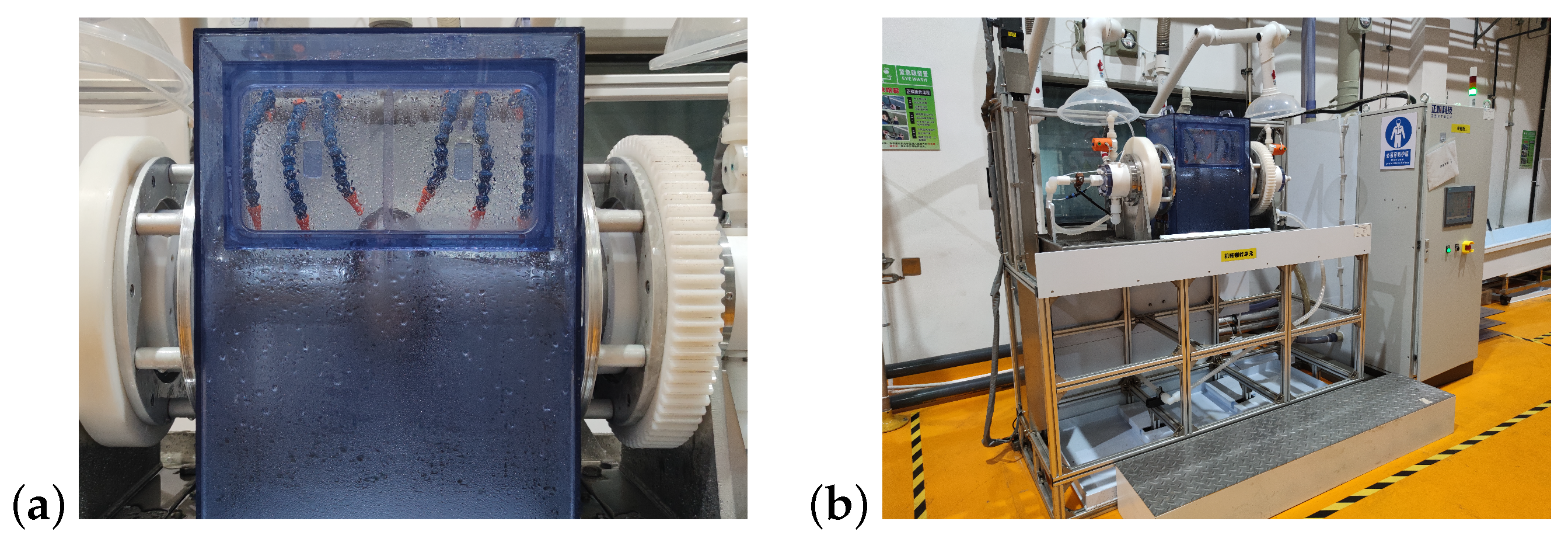
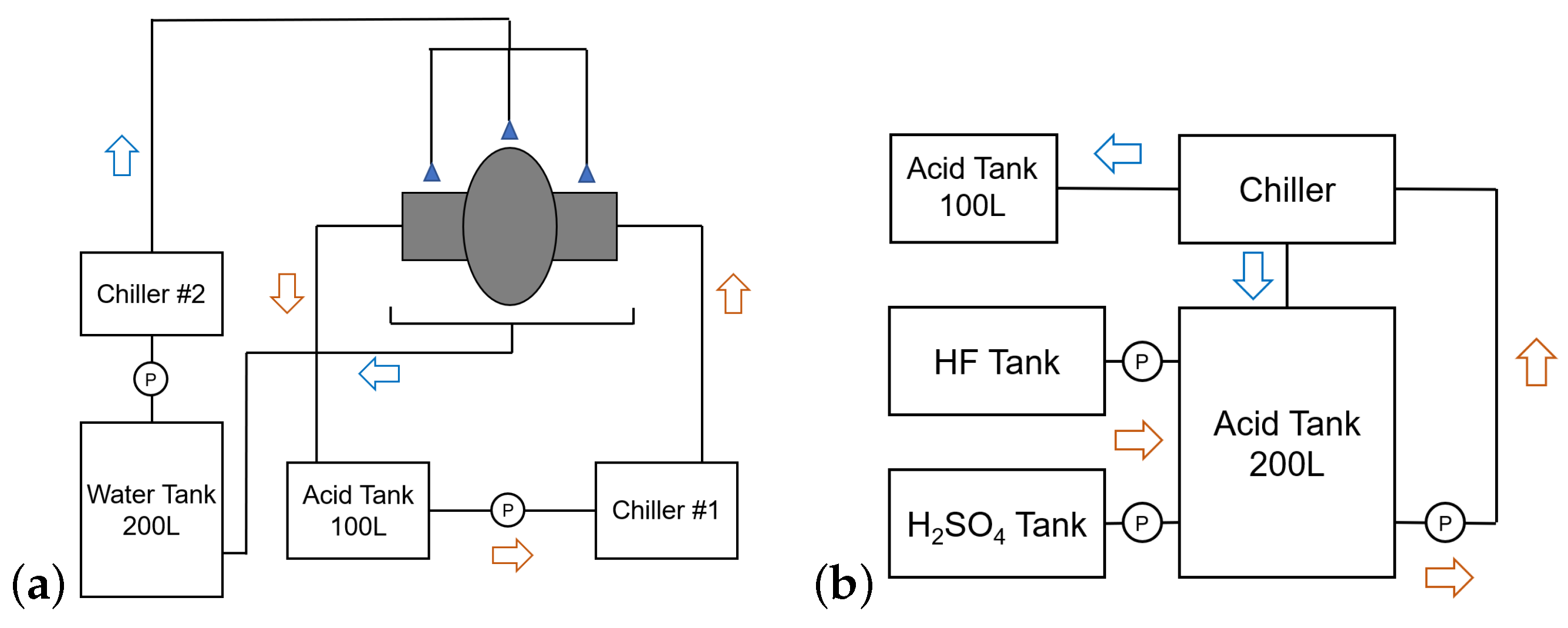
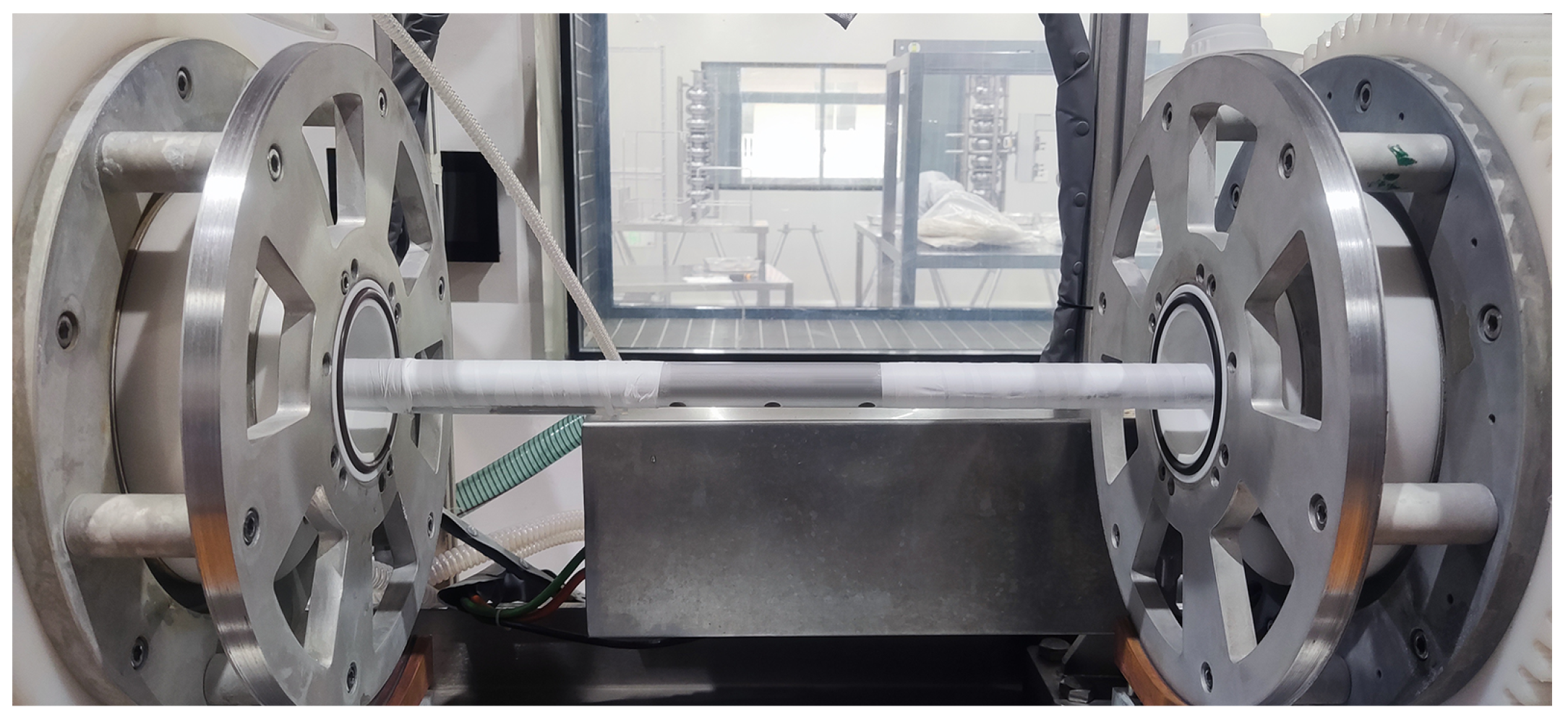

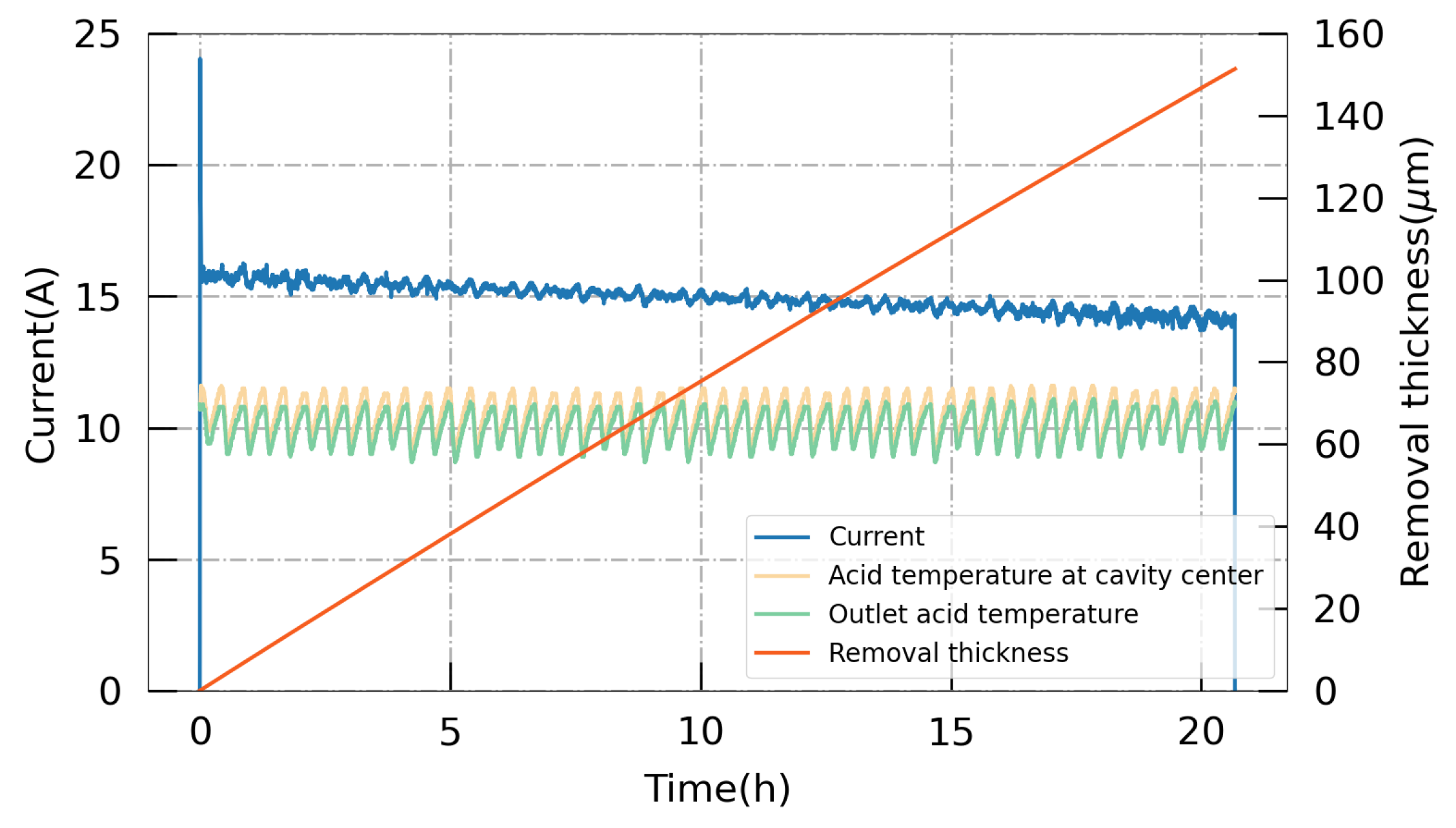

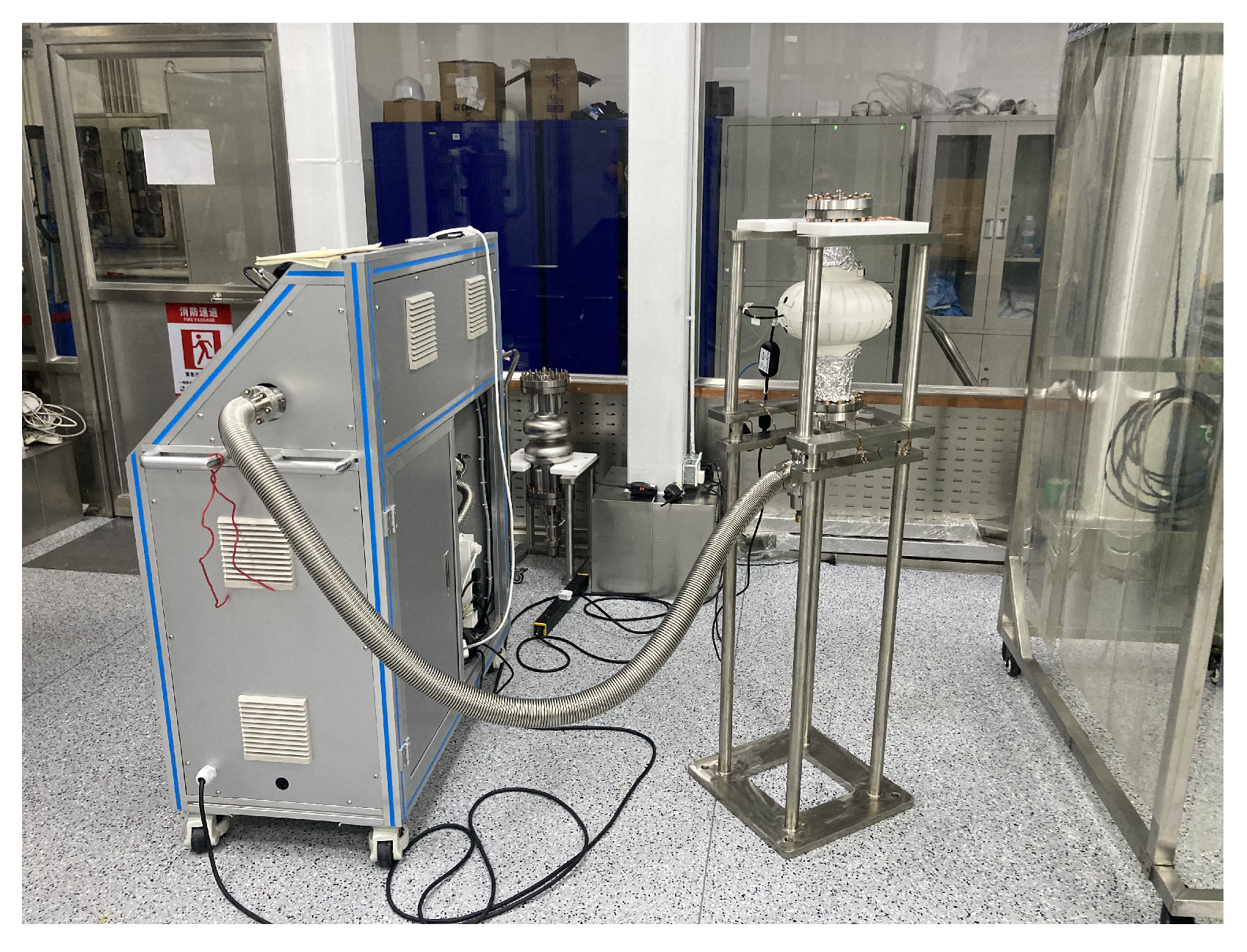

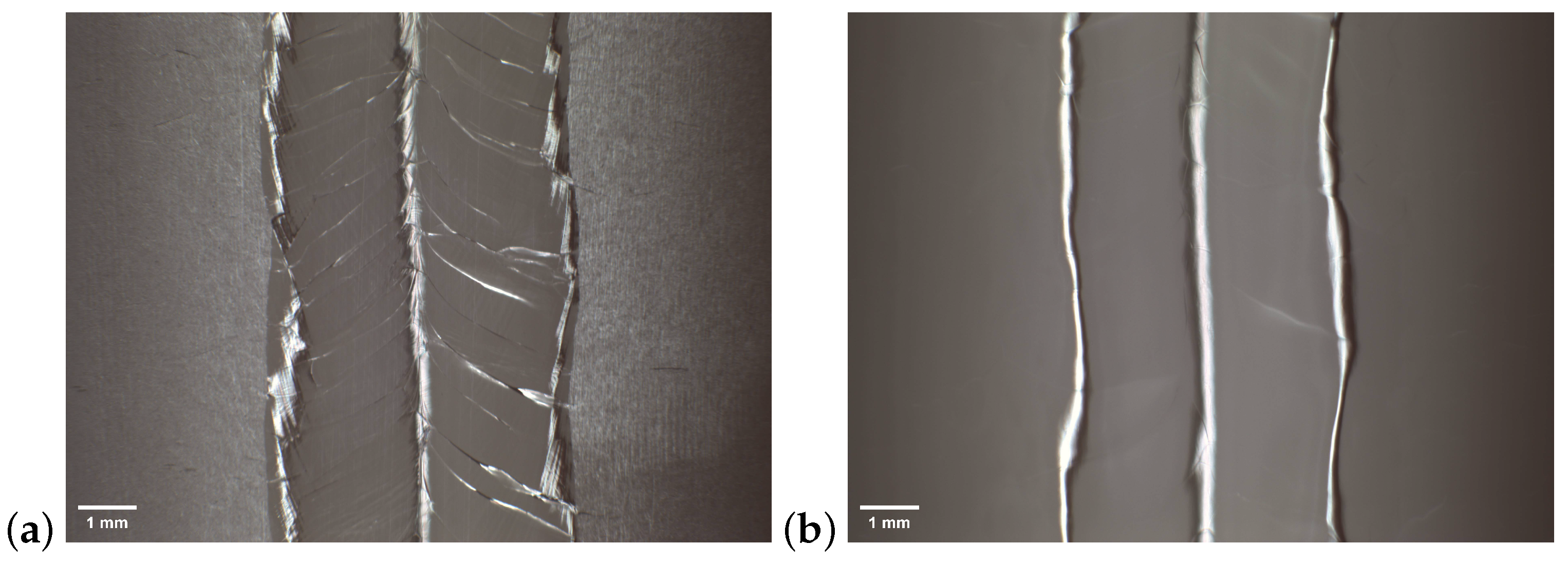
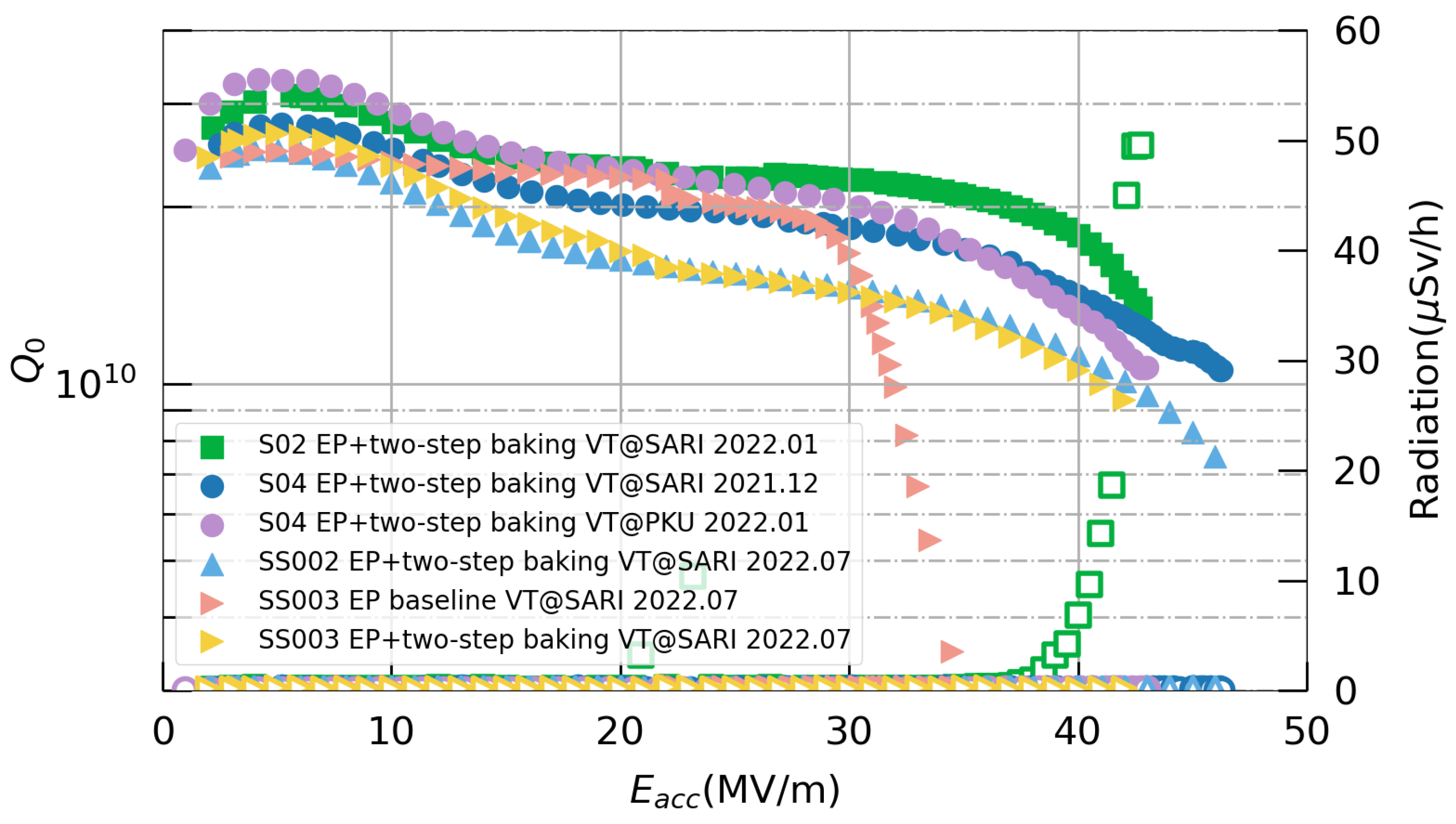



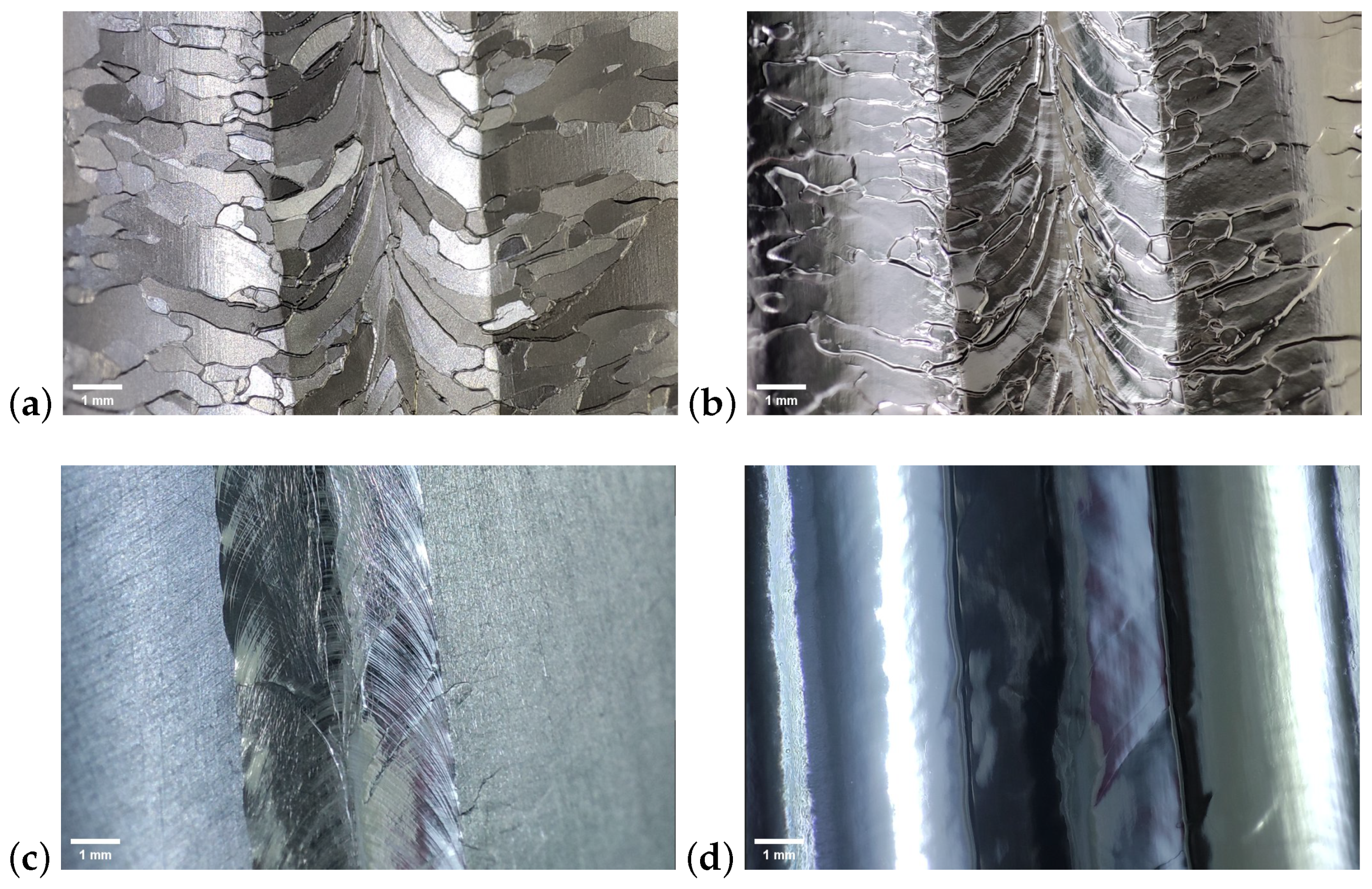


| Parameters | 1.3 GHz Single-Cell Cavity | 3.9 GHz Single-Cell Cavity |
|---|---|---|
| Voltage | 15 V | 20 V |
| Current | ∼15 A | ∼4 A |
| Electrolyte temp. | 10 °C | 10 °C |
| Average removal rate | ∼6 m/h | ∼10 m/h |
| Electrolyte flow rate | 3 L/min | 2 L/min |
| Cavity rotation speed | 1 rpm | |
| Cooling water temp. | 7 °C | |
Disclaimer/Publisher’s Note: The statements, opinions and data contained in all publications are solely those of the individual author(s) and contributor(s) and not of MDPI and/or the editor(s). MDPI and/or the editor(s) disclaim responsibility for any injury to people or property resulting from any ideas, methods, instructions or products referred to in the content. |
© 2024 by the authors. Licensee MDPI, Basel, Switzerland. This article is an open access article distributed under the terms and conditions of the Creative Commons Attribution (CC BY) license (https://creativecommons.org/licenses/by/4.0/).
Share and Cite
Zong, Y.; Chen, J.; Wang, D.; Xia, R.; Wu, J.; Wang, Z.; Xing, S.; Wu, X.; He, X.; Wang, X. Investigation of Electropolishing for High-Gradient 1.3 GHz and 3.9 GHz Niobium Cavities. Materials 2024, 17, 3207. https://doi.org/10.3390/ma17133207
Zong Y, Chen J, Wang D, Xia R, Wu J, Wang Z, Xing S, Wu X, He X, Wang X. Investigation of Electropolishing for High-Gradient 1.3 GHz and 3.9 GHz Niobium Cavities. Materials. 2024; 17(13):3207. https://doi.org/10.3390/ma17133207
Chicago/Turabian StyleZong, Yue, Jinfang Chen, Dong Wang, Runzhi Xia, Jiani Wu, Zheng Wang, Shuai Xing, Xiaowei Wu, Xuhao He, and Xiaohu Wang. 2024. "Investigation of Electropolishing for High-Gradient 1.3 GHz and 3.9 GHz Niobium Cavities" Materials 17, no. 13: 3207. https://doi.org/10.3390/ma17133207
APA StyleZong, Y., Chen, J., Wang, D., Xia, R., Wu, J., Wang, Z., Xing, S., Wu, X., He, X., & Wang, X. (2024). Investigation of Electropolishing for High-Gradient 1.3 GHz and 3.9 GHz Niobium Cavities. Materials, 17(13), 3207. https://doi.org/10.3390/ma17133207






